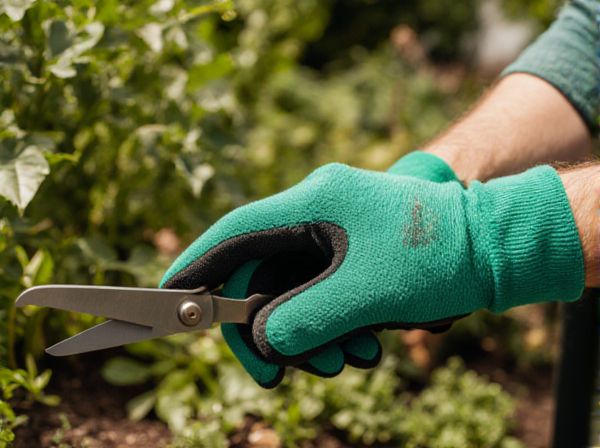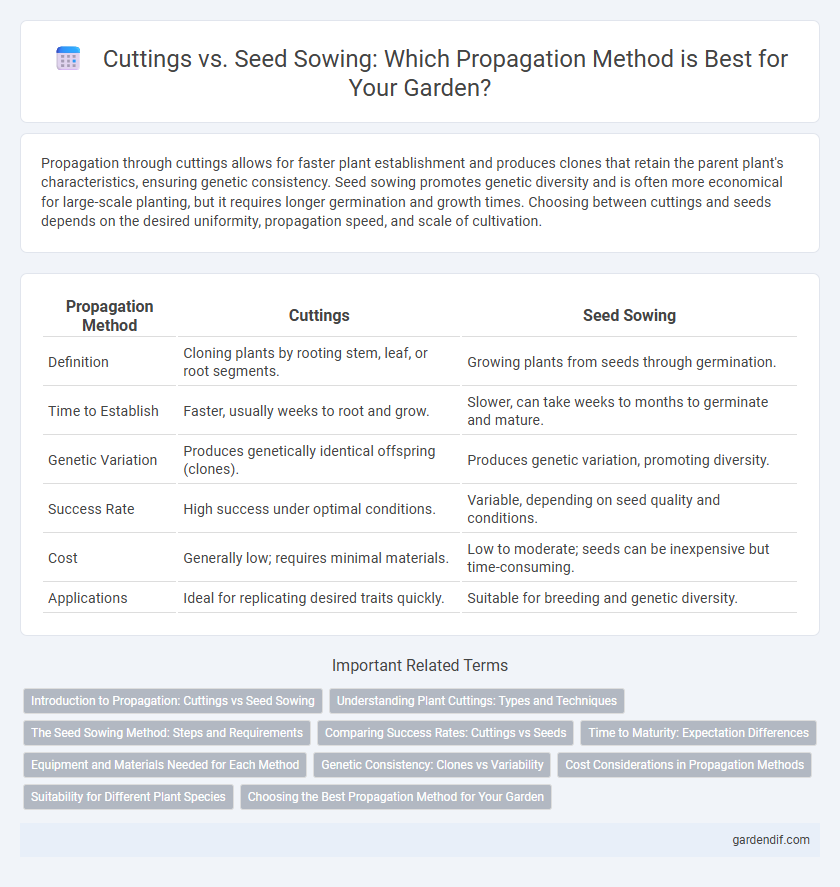
Cuttings vs Seed Sowing Illustration
Propagation through cuttings allows for faster plant establishment and produces clones that retain the parent plant's characteristics, ensuring genetic consistency. Seed sowing promotes genetic diversity and is often more economical for large-scale planting, but it requires longer germination and growth times. Choosing between cuttings and seeds depends on the desired uniformity, propagation speed, and scale of cultivation.
Table of Comparison
| Propagation Method | Cuttings | Seed Sowing |
|---|---|---|
| Definition | Cloning plants by rooting stem, leaf, or root segments. | Growing plants from seeds through germination. |
| Time to Establish | Faster, usually weeks to root and grow. | Slower, can take weeks to months to germinate and mature. |
| Genetic Variation | Produces genetically identical offspring (clones). | Produces genetic variation, promoting diversity. |
| Success Rate | High success under optimal conditions. | Variable, depending on seed quality and conditions. |
| Cost | Generally low; requires minimal materials. | Low to moderate; seeds can be inexpensive but time-consuming. |
| Applications | Ideal for replicating desired traits quickly. | Suitable for breeding and genetic diversity. |
Introduction to Propagation: Cuttings vs Seed Sowing
Propagation methods include cuttings and seed sowing, each offering unique advantages for plant reproduction. Cuttings provide faster growth by cloning the parent plant, ensuring genetic consistency and quicker establishment. Seed sowing promotes genetic diversity and allows for large-scale cultivation, making it ideal for creating new plant varieties.
Understanding Plant Cuttings: Types and Techniques
Plant cuttings involve taking a portion of a parent plant, such as stem, leaf, or root segments, to propagate new plants genetically identical to the source. Common types of cuttings include stem cuttings, leaf cuttings, and root cuttings, each requiring specific techniques like proper cutting angle, use of rooting hormone, and maintaining optimal humidity for successful rooting. Understanding these methods enhances propagation efficiency by promoting faster root development and ensuring plant health compared to seed sowing, which involves genetic variability and longer growth periods.
The Seed Sowing Method: Steps and Requirements
Seed sowing requires selecting high-quality seeds, preparing well-draining soil enriched with organic matter, and maintaining consistent moisture and temperature for optimal germination. Seeds are sown at the recommended depth and spacing, covered lightly with soil, and placed in a warm, bright environment to encourage seedling growth. Proper ventilation and regular monitoring prevent fungal diseases and ensure healthy, vigorous plants ready for transplantation.
Comparing Success Rates: Cuttings vs Seeds
Cuttings often yield higher success rates than seed sowing due to their ability to bypass the vulnerable germination phase, ensuring genetic consistency and faster rooting. Seed sowing success varies widely depending on species, seed viability, and environmental conditions, generally showing lower and more variable germination rates. Vegetative propagation through cuttings is preferred for species with difficult seed germination or when uniformity in crop production is critical.
Time to Maturity: Expectation Differences
Cuttings typically result in faster plant maturity, often reaching harvest or flowering stages weeks or months earlier than seed-sown counterparts. Seed sowing involves germination and early growth phases that prolong time to maturity, sometimes doubling the timeline compared to cuttings. Gardeners and commercial growers prioritize cuttings when rapid crop turnover and uniform plant characteristics are critical for productivity.
Equipment and Materials Needed for Each Method
Cuttings require sharp, sterile pruning shears, rooting hormone, humidity domes or plastic covers, and well-draining propagation trays filled with a suitable growing medium like perlite or peat moss. Seed sowing demands seed trays or pots, fine seed-starting soil, a heat mat for optimal germination temperature, and a gentle watering method such as a spray bottle to prevent disturbing seeds. Both methods benefit from labels to track plant varieties and growth stages accurately.
Genetic Consistency: Clones vs Variability
Propagation through cuttings ensures genetic consistency by producing clones identical to the parent plant, preserving desirable traits such as flower color, growth habit, and disease resistance. In contrast, seed sowing introduces genetic variability, resulting in offspring with diverse characteristics that may differ significantly from the parent, which can be advantageous for breeding new varieties but unpredictable for maintaining specific traits. This fundamental difference impacts plant uniformity in commercial production and biodiversity in horticultural practices.
Cost Considerations in Propagation Methods
Propagation by cuttings generally incurs lower initial costs than seed sowing due to reduced need for nurseries, seed purchase, and germination equipment. Cuttings enable faster establishment, decreasing labor and operational expenses over time, especially for woody plants and ornamentals. Seed sowing may require higher investment in seed treatments, trays, and controlled environments, impacting overall propagation budget.
Suitability for Different Plant Species
Cuttings offer a faster propagation method ideal for plants that root easily, such as succulents, herbs, and many shrubs, ensuring genetic consistency with the parent plant. Seed sowing suits species with tough cuttings or those propagating genetic diversity like vegetables, flowers, and trees. Understanding plant-specific growth habits and environmental requirements determines whether cuttings or seeds provide optimal propagation success.
Choosing the Best Propagation Method for Your Garden
Cuttings enable faster propagation by producing genetically identical plants, ideal for maintaining specific traits, while seed sowing offers greater genetic diversity and resilience in garden populations. Cuttings require proper handling and environmental controls to ensure root development, whereas seed sowing demands more time but can yield a higher volume of plants. Selecting the best propagation method depends on plant species, desired traits, available resources, and the gardener's long-term goals.
Cuttings vs Seed Sowing Infographic

 gardendif.com
gardendif.com